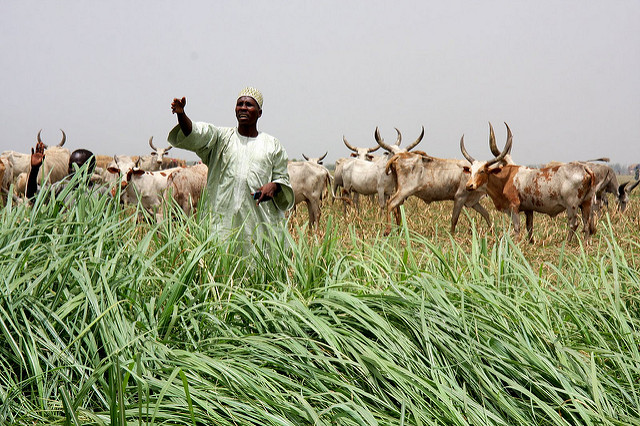Should I prioritize crop farming or livestock husbandry on my farm? Which will give me the best income and help ensure my family have enough to eat? People in poor, rural communities in the Sahel are asking themselves these very questions. But what’s the answer?
Analysis shows that many are opting for cultivation as people convert grassland, historically used for grazing, into farms. A study by the International Livestock Research Institute in western Niger found rapid changes taking place in key grazing areas of savannah grasslands. In 1950, 44 to 70 percent of areas covered with savannah grassland were used for grazing; these grasslands have now largely disappeared as the land has been converted to crop farms. This trend has been gaining momentum as populations expand, demands for food continue to increase, the fertility of soils on existing farms decreases, and the impacts of climate variability get worse. Less fertile soil means reduced yields or the need for supplementary (and often costly) fertilizers, which can have their own environmental impacts.
As more and more land is converted from either grazing pasture or grassland, to farmland, the availability of fodder resources is falling drastically. Crop residues are used as fodder but sometimes this resource is merely burned while preparing farmland for the next cropping season. This means that the very ecosystem services that the farmers need to have productive lands are being diminished by the farming practices.
Viewing this in reverse, if livestock numbers were to increase and both they and the manure they produce were managed effectively, this could have a significant positive impact by transferring and recycling soil nutrients and improving soil structure and fertility. At the same time, these activities would lead improved incomes and nutrition through the sale or consumption of the meat, milk, eggs and other livestock products.
Another negative impact that the trend of converting land to cropland results in might not be immediately obvious. As access to suitable grazing areas and places where fodder can be gathered decreases, so the potential for conflict between pastoralist communities who move with the seasons and more sedentary farming communities in these areas increases. These two groups increasingly find themselves competing over a finite, in fact shrinking, amount of natural resources. In 2012, the Burkina Faso Ministry of Animal Resources estimated that around 600 conflicts occur each year, resulting in the death of pastoralists, farmers and government workers (as many as 100 between 2010-12), and the destruction of property or loss of animals.
Identifying innovative ways to secure and increase livestock fodder resources through effective management and production therefore has the potential to simultaneously achieve a number of objectives: improving incomes and food security; reducing inter-community conflict; and improving ecosystem health and resilience.
A WLE project, Realizing the full biomass potential of mixed crop-livestock systems in rapidly changing Sahelian agro-ecological landscapes, was launched in 2014 to explore how better management could be achieved. The research aimed to investigate gender gaps and assess how women and youth, when given opportunities, can contribute to and benefit from improved fodder production and mixed crop-livestock systems. It addressed three questions:
- What are the opportunities and effects of fodder management practices on agricultural productivity, food security, livelihoods and ecosystem services related to soil and water?
- What are the trade-offs and socio-economic barriers associated with fodder production and use by different types of farmer and among men, women and youth?
- What are the potential opportunities for expanding the use of promising ecosystem-enhancing fodder management practices?
Researchers focused on two sites in the semi-arid north of the Volta and Niger River basins (four villages in Yatenga province in northern Burkina Faso, and four villages in Fakara district in south-western Niger). They found that a number of opportunities exist to increase sustainable productivity, enhance equity, improve incomes and spread the benefits of fodder production more widely in both Burkina Faso and Niger. Four key recommendations have been made by the research team:
- Implement initiatives enhancing women’s and youth’s control of, and access to, fodder production and supply value chains
- Strengthen local institutions to foster greater participation of women and youth and ensure that their access and control are key factors when introducing improved fodder production technologies and practices
- Promote innovative ways to communicate good practices in fodder production and management in local languages
- Facilitate the creation, or strengthening, of multi-stakeholder platforms for managing fodder and feed production, in ways that consider short and long-term environmental aspects of land and water resources and ecosystem services
Ecosystems, and ecosystem health and resilience, lie at the nexus of productive crop and sustainable fodder production and management. Both systems rely on, and can positively impact, ecosystem services. So the question isn’t so much ‘Should I feed the family or our cattle?’ but how can I do both in ways that mutually enhance each other. The answer lies in appropriate consideration of the interconnectedness of these activities with the ecosystems they rely on and the full and effective integration of women and youth in both fodder and farming production and management systems.
For more information on this project and its findings read the brief Improving livestock fodder production through greater inclusion of women and youth.
Thor Windham-Wright is the research uptake and communications coordinator for Africa at the International Water Management Institute, based in Accra. This post first appeared on the CGIAR Research Program on Water, Land, and Ecosystems Thrive blog.







